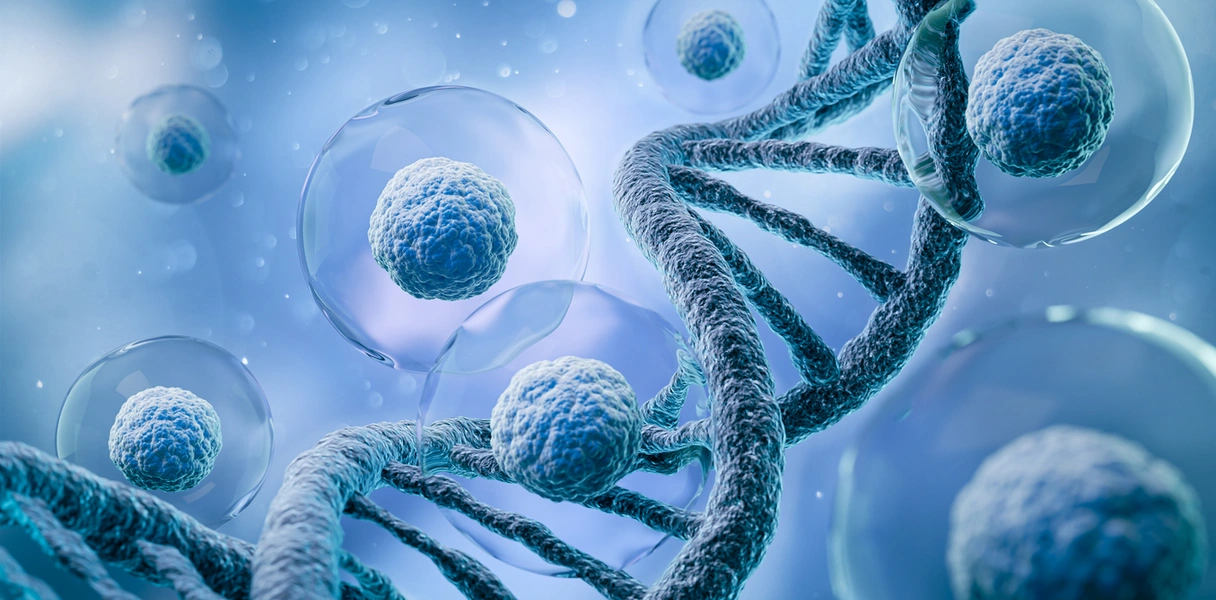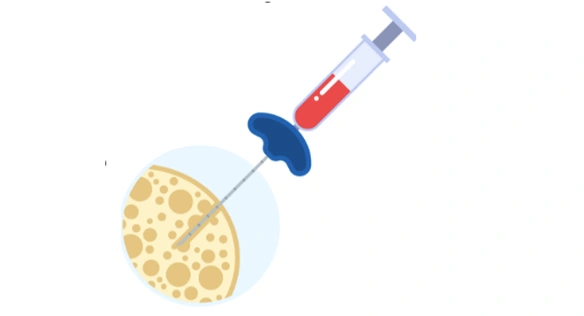A small sample of cells is taken from the outer layer of the embryo, the part that will eventually form the placenta. This biopsy is performed at the blastocyst stage, that is, when the embryo is 5 or 6 days old.
PGT (preimplantation genetic testing)
The technique that helps select embryos free of genetic alterations

What does the law say about preimplantation genetic diagnosis (PGD) in Spain?
According to Law 14/2006 on Assisted Human Reproduction Techniques, PGD is authorised to select embryos for therapeutic purposes. Under this framework, two situations are established:
- The detection of serious hereditary diseases, of early onset, not susceptible to postnatal curative treatment
- The detection of alterations that may compromise embryo viability and therefore result in implantation failure
PGT Complete
We include this comprehensive aneuploidy test in all our IVF/ICSI+PGD treatments.
At Fertility Madrid, we use the only PGT-A that applies artificial intelligence (AI) based on clinical outcome data, eliminating subjectivity and improving accuracy in detecting anomalies in embryos before implantation. This increases ongoing pregnancies and live births by 13% and significantly reduces early pregnancy losses. It also provides the additional benefit of guaranteeing embryo parentage.
We have enhanced this aneuploidy test with PGT-COMPLETE, which builds on PGT-A with three clinical improvements:
- Parental quality control – ensures parentage of embryos by confirming that the embryo biopsy sample matches the parental samples provided.
- Rescue of abnormal pronuclear embryos – embryos showing 0, 1, or 3 pronuclei morphologically, which later reach the blastocyst stage, can be biopsied and analysed for chromosomal abnormalities. This increases the chances of having more euploid embryos.
- Identification of the origin of aneuploidy – provides information on whether the abnormality originates from the egg or sperm, which is valuable when considering donor gametes.
Advantages of PGT-Complete
- Patented artificial intelligence, avoiding interpretation errors
- Increases chances of pregnancy
- Rescue of 2PN embryos
- Identification of the origin of aneuploidy
- Guarantee of embryo parentage
- Improves embryo selection
- Avoids transfer of embryos that will not implant
- Avoids transfer of embryos that may cause miscarriage or syndromic conditions
- Reduces time to achieve pregnancy
- Lower cost
- Supports psychological wellbeing
Who can undergo PGT?
We always take into account the reality and needs of each person who comes to our clinic. Preimplantation genetic testing may be suitable for you if you are concerned about any of the following:

If you identify with any of these situations, we are here to support you and help you find the path to safe motherhood or fatherhood.
- You, your partner, or both are carriers of mutations in individual genes and wish to avoid transmitting them to your children
- One partner has a chromosomal rearrangement (e.g. translocation), which may cause chromosomal variations in eggs or sperm, increasing the risk of miscarriage or health problems in the baby
- You have had a previous pregnancy affected by a chromosomal alteration
- Advanced maternal age (e.g. over 38) and wishing to rule out Down syndrome or other anomalies
- Recurrent miscarriages
- Repeated IVF failures
- Partner with teratozoospermia or severe oligozoospermia requiring ICSI (intracytoplasmic sperm injection)
- You or your partner have undergone cancer treatments (chemotherapy or radiotherapy) in the last year
How does PGT work?
After the biopsy, the embryo must be frozen, since genetic testing requires time and does not allow immediate fresh embryo transfer.
Results are usually available within 2 to 4 weeks after the procedure. The biopsy is always performed by a senior embryologist with extensive experience, ensuring accuracy and safety at all times.
Embryo biopsy
IVF cycle and embryo creation
Embryos are created using standard in vitro fertilisation (IVF) methods. Eggs are collected and fertilised with sperm, then cultured in a controlled laboratory environment.
Genetic analysis of embryonic cells
Embryonic cells are analysed to detect genetic conditions or chromosomal abnormalities. This may include PGT-A, PGT-M, or PGT-SR, depending on the purpose of the study.
Results and embryo selection
Once the analysis is complete, a report is shared with the fertility medical team to help determine which embryos are suitable for transfer and have the highest likelihood of resulting in a viable pregnancy.
What types of PGT exist and when are they recommended?
PGT-A for the detection of aneuploidies
This test makes it possible to identify numerical alterations in chromosomes. Some of the most well-known chromosomal diseases that can be detected with this test are:
- Down syndrome
- Patau syndrome
- Edwards syndrome
- Turner syndrome
- Klinefelter syndrome
During human reproduction, it is not uncommon for embryos to form with an incorrect number of chromosomes — this is known as aneuploidy.
PGT-A is used to evaluate the most common embryonic chromosomal alterations. Couples facing fertility problems may benefit from this test in cases such as:
- Women of advanced reproductive age (close to 40 years old)
- Women who have experienced a miscarriage
- Presence of a numerical anomaly in the sex chromosomes (X or Y) in one or both partners
- Presence of a numerical chromosomal alteration in one or both partners
PGT-M for the detection of monogenic diseases
- Sickle cell anaemia
- Cystic fibrosis
- Phenylketonuria
- Batten disease
We recommend PGT-M or PGT-SR in cases of:
- Presence of a genetic disease in one or both partners
- Presence of a genetic disease or anomaly in the family of one or both partners
PGT-SR: preimplantation genetic testing for structural rearrangements
Some of the best-known chromosomal abnormalities, such as Prader-Willi syndrome or Angelman syndrome, can be prevented thanks to this type of preimplantation genetic test.
Indications for PGT-SR
- Presence of a structural chromosomal alteration or abnormality in one or both partners
Frequently asked questions about PGT
What monogenic diseases can PGT detect?
We can test for all single-gene diseases, including:
- Huntington’s disease
- Cystic fibrosis
- Thalassaemia
- Duchenne muscular dystrophy
- Fragile X syndrome
- BRCA1/BRCA2 mutations (hereditary risk of breast and ovarian cancer)
Can I use PGT to select the sex of the embryo?
Sex selection is only permitted for medical reasons, not for balancing the number of children by gender.
In cases where certain genetic diseases affect only one sex (such as haemophilia or Duchenne muscular dystrophy), and the exact mutation on the X chromosome cannot be detected, PGT may be used to transfer embryos of the unaffected sex.
Does PGT damage the embryo?
Current research shows that the implantation probability of a biopsied embryo is the same as that of one that has not been biopsied.
No health problems have been reported in children born after embryo biopsy as part of a PGT treatment.
What does PGT involve?
During PGT, the woman undergoes a standard IVF cycle. The embryos are then vitrified and genetically analysed. We evaluate:
-
The number of chromosomes or chromosomal segments (PGT-A, PGT-SR)
-
The embryo’s genotype, predisposition, or genetic risk (PGT-M)
How much does PGT cost?
Our prices vary depending on the type of test and the personalised treatment plan. Please see our price section above or contact us directly for an exact, tailored quote.
What is the difference between PGT-A, PGT-M, and PGT-SR?
-
PGT-A: detects abnormalities in the number of chromosomes (aneuploidies)
-
PGT-M: identifies hereditary diseases caused by single-gene mutations
-
-
PGT-SR: analyses structural chromosome alterations, such as translocations
-
Does PGT guarantee a successful pregnancy?
No. PGT increases the chances of success by selecting chromosomally normal embryos, but other factors such as endometrial receptivity and uterine health also play a role.
When is PGT-A recommended?
Especially for women of advanced maternal age, in cases of recurrent miscarriages, previous IVF failures, or when minimising the risk of chromosomal abnormalities in pregnancy.
Is embryo biopsy safe?
Yes. The current technique, performed at the blastocyst stage, is safe and does not compromise implantation potential, provided it is carried out by specialised embryologists.
What are the limitations of PGT?
-
It cannot detect all existing genetic diseases
-
There is a small risk of misdiagnosis or embryo mosaicism
-
-
It should always be accompanied by appropriate genetic counselling
-
How long do PGT results take?
Generally between 2 and 4 weeks after embryo biopsy. During this time, embryos remain safely frozen.
What is embryo mosaicism and how does it affect PGT?
Mosaicism occurs when an embryo has both normal cells and cells with chromosomal alterations. In some cases, mosaic embryos may implant and develop, but they require very careful evaluation before transfer.
Can PGT be used in treatments with donor eggs?
Yes. It may be recommended to rule out chromosomal abnormalities, especially when the male factor shows severe problems or when maximising implantation rates is desired.